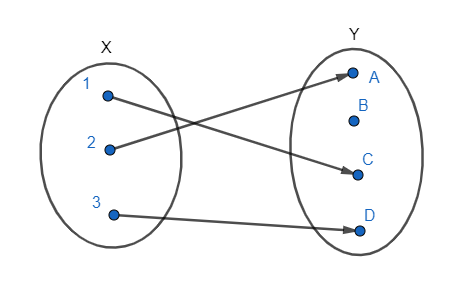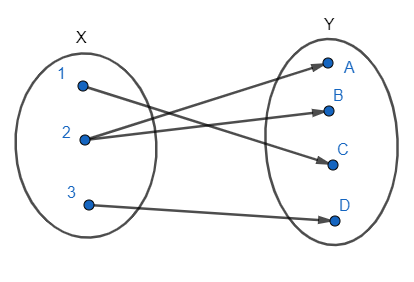
Give an example of the function.
(i) Which is one-one but not onto.
(ii) which is not one-one but onto.
(iii) which is neither one-one nor onto.
Answer
567k+ views
Hint: To solve this question, we will first understand what is one to one function and what is onto function. Then, we will see the defined some basic functions and check whether they are one to one or onto or neither.
Complete step by step answer:
A function is called one to one function if every element of its domain has a unique element in the range. It is also called injective function. We can see the mapping of the function in the following figure.

If the domain of a function is X: {1, 2, 3} and the range is Y: {A, B, C, D}, then in one to one mapping, every element of X will have only one corresponding element in Y.
Now, let us define onto function. A function is called onto function if for every element in the range, there is at least one element in the domain of the function. It is also called surjective function. We can see the mapping of the function in the following figure.

If the domain of a function is X: {1, 2, 3} and the range is Y: {A, B, C, D}, then on mapping, every element of Y will have at least one corresponding element in X.
Let us consider that $f\left( x \right)=3x$is a function with domain as a set of all integers. According to the definition of the function, the range will also be a set of integers.
Now, if $x=1$, $f\left( x \right)=3$. Similarly, if $x={{x}_{1}}$, $f\left( {{x}_{1}} \right)=3{{x}_{1}}$.
Thus, for every x, there is a unique $f\left( x \right)$. Thus, $f\left( x \right)=3x$ is one to one function.
For the function to be onto, every element of the range should have at least one element in the domain.
Let $f\left( x \right)=y$, such that y is an integer.
$\begin{align}
& \Rightarrow y=3x \\
& \Rightarrow x=\dfrac{y}{3} \\
\end{align}$
If $y=1\Rightarrow x=\dfrac{1}{3}$, which does not belong to integers.
Therefore, $f\left( x \right)=3x$ is one-one function but not onto function.
Consider a function $g\left( x \right)=5$, defined from integers to a set containing only number 5.
For any value of x, $g\left( x \right)=5$. Hence, this is not one to one function.
And for every element in the range, which has only one element, there is a corresponding element in the domain.
Hence, $g\left( x \right)=5$ is not one-one but onto function.
Next consider $h\left( x \right)={{x}^{2}}$, where the domain of real numbers and the range of the function is also real numbers.
Now, if $x=1$, $h\left( x \right)=1$ and if $x=-1$, then also $h\left( x \right)=1$. Therefore, the function is not one to one function.
Let $h\left( x \right)=y$, where y belongs to real numbers.
$\begin{align}
& \Rightarrow {{x}^{2}}=y \\
& \Rightarrow \pm \sqrt{y}=x \\
\end{align}$
But since y is under square root, it cannot take negative values. Therefore, not element of range has a corresponding element in the domain.
Therefore, $h\left( x \right)={{x}^{2}}$ is neither one to one, nor onto.
Hence, example of one-one but not onto function is $f\left( x \right)=3x,f:N\to N$
Example of not one-one but onto function is $g\left( x \right)=5,g:\text{N}\to \left\{ 5 \right\}$
And example of neither one-one nor onto function is $h\left( x \right)={{x}^{2}},h:\text{R}\to \text{R}$
Note: The given functions are only samples and there are many functions out there which satisfy the conditions of one-one, onto or neither. A function is one-one function if it satisfies the condition that $f\left( {{x}_{1}} \right)=f\left( {{x}_{2}} \right)$, then ${{x}_{1}}={{x}_{2}}$ . A function is onto function if the range of the inverse is the domain of the original function.
Complete step by step answer:
A function is called one to one function if every element of its domain has a unique element in the range. It is also called injective function. We can see the mapping of the function in the following figure.

If the domain of a function is X: {1, 2, 3} and the range is Y: {A, B, C, D}, then in one to one mapping, every element of X will have only one corresponding element in Y.
Now, let us define onto function. A function is called onto function if for every element in the range, there is at least one element in the domain of the function. It is also called surjective function. We can see the mapping of the function in the following figure.

If the domain of a function is X: {1, 2, 3} and the range is Y: {A, B, C, D}, then on mapping, every element of Y will have at least one corresponding element in X.
Let us consider that $f\left( x \right)=3x$is a function with domain as a set of all integers. According to the definition of the function, the range will also be a set of integers.
Now, if $x=1$, $f\left( x \right)=3$. Similarly, if $x={{x}_{1}}$, $f\left( {{x}_{1}} \right)=3{{x}_{1}}$.
Thus, for every x, there is a unique $f\left( x \right)$. Thus, $f\left( x \right)=3x$ is one to one function.
For the function to be onto, every element of the range should have at least one element in the domain.
Let $f\left( x \right)=y$, such that y is an integer.
$\begin{align}
& \Rightarrow y=3x \\
& \Rightarrow x=\dfrac{y}{3} \\
\end{align}$
If $y=1\Rightarrow x=\dfrac{1}{3}$, which does not belong to integers.
Therefore, $f\left( x \right)=3x$ is one-one function but not onto function.
Consider a function $g\left( x \right)=5$, defined from integers to a set containing only number 5.
For any value of x, $g\left( x \right)=5$. Hence, this is not one to one function.
And for every element in the range, which has only one element, there is a corresponding element in the domain.
Hence, $g\left( x \right)=5$ is not one-one but onto function.
Next consider $h\left( x \right)={{x}^{2}}$, where the domain of real numbers and the range of the function is also real numbers.
Now, if $x=1$, $h\left( x \right)=1$ and if $x=-1$, then also $h\left( x \right)=1$. Therefore, the function is not one to one function.
Let $h\left( x \right)=y$, where y belongs to real numbers.
$\begin{align}
& \Rightarrow {{x}^{2}}=y \\
& \Rightarrow \pm \sqrt{y}=x \\
\end{align}$
But since y is under square root, it cannot take negative values. Therefore, not element of range has a corresponding element in the domain.
Therefore, $h\left( x \right)={{x}^{2}}$ is neither one to one, nor onto.
Hence, example of one-one but not onto function is $f\left( x \right)=3x,f:N\to N$
Example of not one-one but onto function is $g\left( x \right)=5,g:\text{N}\to \left\{ 5 \right\}$
And example of neither one-one nor onto function is $h\left( x \right)={{x}^{2}},h:\text{R}\to \text{R}$
Note: The given functions are only samples and there are many functions out there which satisfy the conditions of one-one, onto or neither. A function is one-one function if it satisfies the condition that $f\left( {{x}_{1}} \right)=f\left( {{x}_{2}} \right)$, then ${{x}_{1}}={{x}_{2}}$ . A function is onto function if the range of the inverse is the domain of the original function.
Recently Updated Pages
Master Class 12 Business Studies: Engaging Questions & Answers for Success

Master Class 12 Economics: Engaging Questions & Answers for Success

Master Class 12 English: Engaging Questions & Answers for Success

Master Class 12 Maths: Engaging Questions & Answers for Success

Master Class 12 Social Science: Engaging Questions & Answers for Success

Master Class 12 Chemistry: Engaging Questions & Answers for Success

Trending doubts
What are the major means of transport Explain each class 12 social science CBSE

Which are the Top 10 Largest Countries of the World?

Draw a labelled sketch of the human eye class 12 physics CBSE

How much time does it take to bleed after eating p class 12 biology CBSE

Explain sex determination in humans with line diag class 12 biology CBSE

Differentiate between homogeneous and heterogeneous class 12 chemistry CBSE




